Aquarium snails often display fascinating and quirky behaviors—including floating. While this can sometimes be a harmless and natural occurrence, it might also signal issues in the tank.
This guide explores the reasons behind floating snails, from changes in water quality to natural buoyancy tricks, and provides actionable tips to identify whether your snail is healthy, hungry, stressed, or unwell. Discover how to maintain ideal tank conditions, ensure your snail’s well-being, and distinguish between playful behavior and potential health concerns.

You’ll eventually witness any Mystery snail floating around for hours or days, and sometimes even hanging out of its shell while doing so. This can either happen at the top of the aquarium or in the middle water column. But is it dead? Or this is another weird character trait?
Knowing what to do when you notice your aquarium snail lifelessly floating back and forth is important as it may indicate issues with the water in the tank.
Why is my aquarium snail floating?
Mystery snails are well known for their unusual behavior, especially when it comes to escaping the aquarium without a trace or their acrobatic tricks, such as jumping off the tank’s walls.
However, most water snails may occasionally find themselves afloat.
Confirmed reports I’m aware of include not only Apple snails but also Ramshorn and Bladder snails doing this.
With that being said, here are the most common reasons why your aquarium snail may be floating:
An aquarium snail may be afloat at the top of the fish tank because of a sudden change in water parameters. The snail deliberately traps air in its shell and floats away in an attempt to change locations.
Another reason for floating may be the search for food on the water surface.
In some cases, if the floating lasts for more than a couple of days, it may be an indication that the snail is ill or even dead.
If a snail has died withint its shell by something like old age or an illness then it will likely float.
Empty snail shells don’t float.
If your snail was sucked out of its shell by a loach or other snail-eating fish in your aquarium then the empty shell will remain at the bottom of the tank.
To recap – all shelled dead snails will float but not all floating snails are necessarily dead.
Another thing I want to get our of the way is that a floating snail is not sleeping. Snails are very adept at controlling what’s happening in their shell and how much air it holds.
If simply falling asleep caused them to lose that control and float, exposing themselves to predators on the water surface, it would be detrimental to their population as a whole.
A sleeping snail has its ways to remain steady on a surface underwater.
That being said, let me discuss each reason a snail may float in detail.
1. It’s stressed from a change in the water’s parameters.
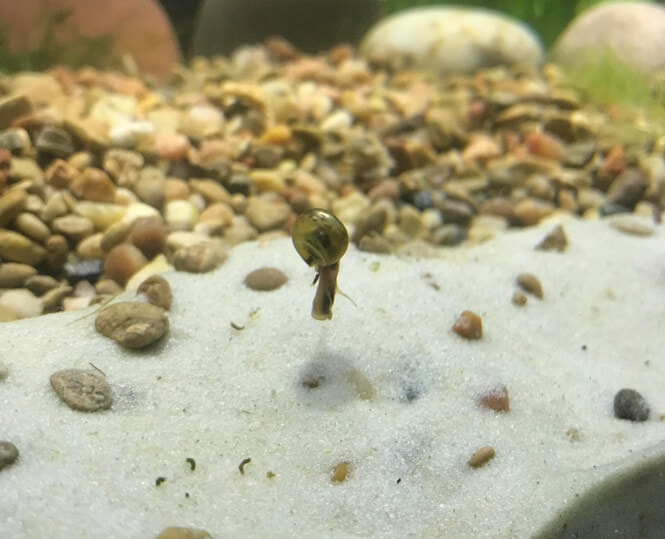
Mystery snails can float at the surface of the fish tank if they are not comfortable with the water parameters.
The floating is an escape mechanism they’d use in the wild to get away from pollution.
If that is the case, you will see them continuously trying to either escape the aquarium or to hang out of their shell.
Both are a reflection of their survival instincts, and since they can’t do anything about the water quality, they will try to float away by using the current.
Usually, a snail would begin to float right after a large water change or if it’s just been introduced to the aquarium.
This happens because the snail becomes somewhat stressed from the sudden change in water parameters.
More often than not the parameter that’s causing the stress is either the temperature or the pH of the water.
2. It has been poisoned by copper from a fertilizer.
Some aquarium plant fertilizers may contain copper.
Small amounts of Copper are beneficial for aquarium plant growth, however, in higher doses, it is deadly to invertebrates such as snails or shrimp.
If you’ve been inadvertently dosing an aquarium fertilizer with copper to the fish tank your snail has likely been poisoned.
Snails may float when feeling sick or dying. A good indication that an aquarium snail might be ill is the creature hanging out of its shell, without trying to attach to anything.
In this case, you should immediately relocate it to a tank with crystal clear water.
Another sign that the snail is being poisoned by something is the prolonged floating of days or even weeks.
Note that some aquarium plant fertilizers contain copper in a safe range for invertebrates.
3. It wants to change locations.
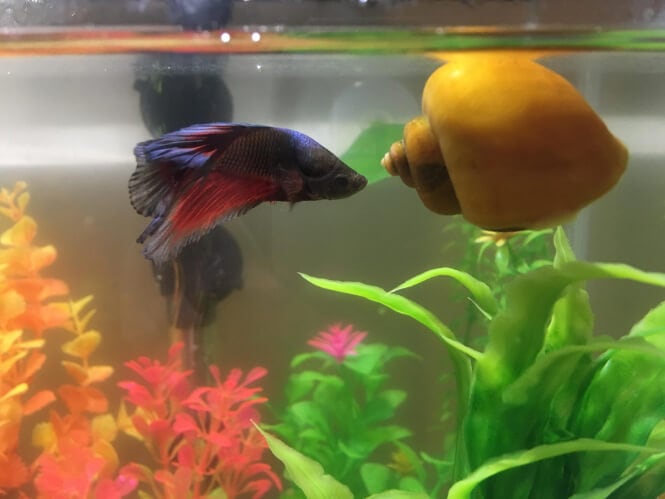
Aquarium snails, in general, are known as slow-moving species, yet sometimes they use a small trick to move faster from one location to another.
Some snails, such as the Mystery snail, which is a type of Apple snail, can hold air into their lungs and that’s just natural behavior for them.
When sharply closing their shell, a small amount of air gets stuck in there in the form of a bubble.
They use it to start floating to another location.
Once they open their shell and the air is released, they sink.
Sometimes they may close their shells due to aggressive tank mates or a strong filtration system.
This type of behavior is normal for them and it is the most common reason you see them floating around the aquarium while being alive and well.
They may do it quite regularly.
Such behavior may also be seen in smaller species of aquatic snails such as the Bladder snails, and sometimes, Ramshorn snails as well.
Holding air in their shells is a conscious decision that the snails make when they want to float.
It’s a myth that aquatic snails trap air in their lungs or shells by accident.
If the snail did that it has done so for a reason.
If you suspect that’s the case then you should not help the animal.
Don’t massage it or whatever to “help” it release the trapped air.
When the snail feels comfortable to get back to the bottom – it will.
I see this myth getting repeated on the Internet and I have no idea where this notion came from.
4. It seeks food on the water surface.
If your small-shelled friends are hungry for some protein film, they may go on a floating quest for food.
They will purposefully float to the top of the fish tank and remain attached to the water surface, upside-down.
When the aquarium is well established with some fish, and some live plants or algae, snails will have enough sources of food.
Nevertheless, if you have a new fish tank or your established one is populated mainly with snails, you will often see them floating on the top of the water, eating a thin surface film.
The film itself is composed of leftover food particles and proteins coming from live plants.
This film is harmless to the aquatic snails and other tank inhabitants, and it’s also a Mystery snail’s favorite snack.
5. Your snail has died of old age.
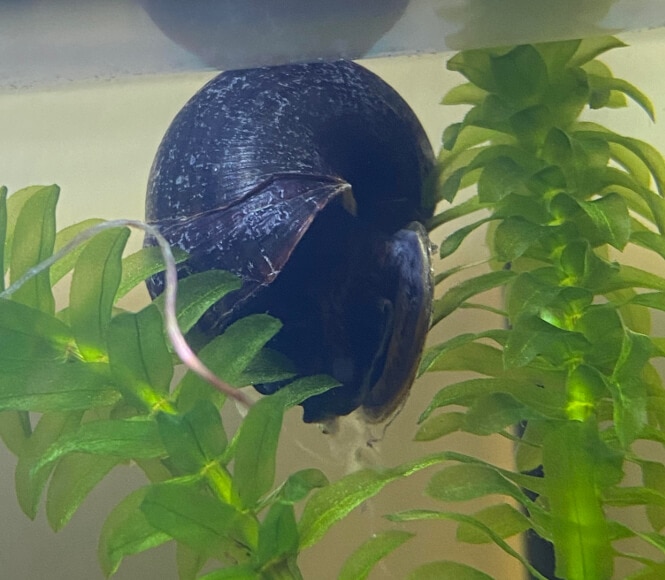
Aquarium snails will float when they die of old age.
If you haven’t been looking after yours since it was a baby, it may be that the fish store sold you an older snail.
A snail will often begin to float just hours after being added to a new fish tank.
Wait a bit, and rule out the possible shock from the change in water parameters before concluding that the snail is dead.
6. It wants to migrate after laying a batch of eggs.
I’ve seen reports of aquarists who claim their aquatic snail started floating after it laid eggs.
This has two possible explanations:
- The water quality in the aquarium has diminished right after the snail laid the eggs.
A snail won’t lay eggs if the water quality is bad. The snail is probably trying to change locations after it sensed the water parameters in the tank went South.
- The snail has laid eggs and is changing locations as a form of migrational behavior.
Your snail may be seeking a different place to lay another batch of eggs to cover more territory or it is in its nature to change locations after it does so.
Migrational behavior is usually NOT the case with Myster snails but rather Nerite snails who alternate between freshwater and saltwater environments during their life cycle.
What to do to help your aquarium snail return to normal?
First of all, you need to be sure you know what is the reason behind the floating.
- Check the water parameters and aquarium conditions.
Test the levels of ammonia, nitrate, and nitrite.I prefer using a liquid test kit, as based on my experience, it’s more accurate than the strips.
Nitrite and Ammonia levels should be both 0.
Author’s note: Here’s a step-by-step process to follow when you want to lower high Ammonia levels in your fish tank, if that’s the case.
Anyway, to properly assess the water parameters of your fish tank, use something like API’s liquid Master Test Kit
Keep the Nitrate levels low by performing regularly changing between 15 and 25% of the aquarium’s water.
The ideal aquarium pH for most aquatic snails would be between 7.0 and 7.5. The water temperature is best appreciated when in the range of 75 to 85 degrees Fahrenheit (from 23.8 to 29.4°C).
Snails can also be very sensitive to medications in the fish tank. If you have a sick fish in the aquarium, isolate it in a separate hospital tank and treat it there.
Aquarium snails are quite the peaceful species so look for tankmates with a similar temper.
Aggressive tankmates may stress snails and make them wish to escape the aquarium.
Avoid any freshwater fish or critters who are known to consume snails to reduce snail stress.
- Check on your snail’s diet and food.
If your snail spends a lot of time floating upside-down at the tank’s surface or eating the surface film, they might need more food.I’ve heard people claim that aquarium snails eat the waste produced by the rest of the tank’s residents.
That is, however, not true.
Most aquatic snails will eat mainly algae, live plant material, and fish food leftovers.
Having snails in the fish tank doesn’t mean you are free of the cleaning chores.
Relying exclusively on freshwater snails to clean up fish waste is dangerous for all the aquarium pets you have, as the Ammonia levels can spike very quickly.
If you don’t have plants or algae in the aquarium, you can feed your snails with tiny bits of basic algae wafers such as these.
Additionally, for better nutrition, you can feed them with blanched vegetables, such as iceberg lettuce and green zucchini squash.
If you have already checked on the above, but your small friends are still floating, you might consider helping them manually.
Handle them gently and relocate them somewhere they’re able to attach their muscular foot on, like the tank’s wall glass for example.
However, you don’t have to rescue your snails every single time they get air in their shell, as this is not dangerous for them.
I know some snail owners who even say they are sure that their pet snails float just for fun.
How to tell if my snail is dead?
The most certain way to tell if a snail is floating because it died is by examining it closely and smelling it.
The biggest sign a snail is dead is a bad smell coming from its shell.
You can also softly touch its muscular foot a few times.
If you see the body closing up in the shell, the snail is alive and well.
If the body doesn’t move or hangs out of the shell, the snail has likely passed away.
Once you are sure your snail is dead, you need to remove it from the aquarium as quickly as possible.
A partial change of the water will likely be necessary, as otherwise, you risk the health of the other aquatic inhabitants.

It may not be as bad as it appears
Observing an aquarium snail who floats here and there in the aquarium is entertaining.
If this happens often, however, you need to inspect whether there’s an existing problem in the fish tank.
Check the water parameters, temperature, food availability, and tank buddies.
If everything seems fine, then accept that your Mystery friend might be having some fun as part of its quirky nature.





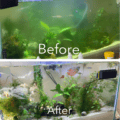




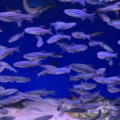
Totally enjoyed your informative knowledge of snails. Great share!
Thanks for the tips. I’ll put some lettuce in now and see if the snail looks happier. I had a lot of plants but the snail ate them all so probably it is hungry!
thank you so much!! i woke up this morning and found my snail (named pepsi) floating and basically had a heart attack!! luckily i found this article and determined that everything this fine 🙂
Hey my snail died on the first day that I got him, but I wanted to know if was old or not?
Can you tell me how to tell young and old snails apart?
How big was it? The older snails are bigger.